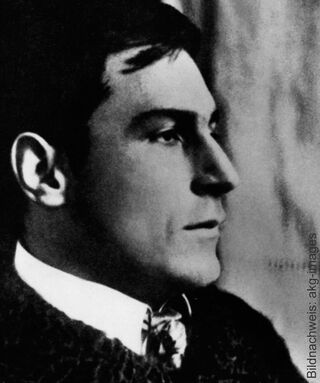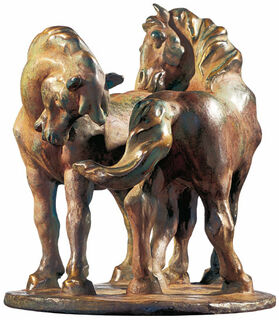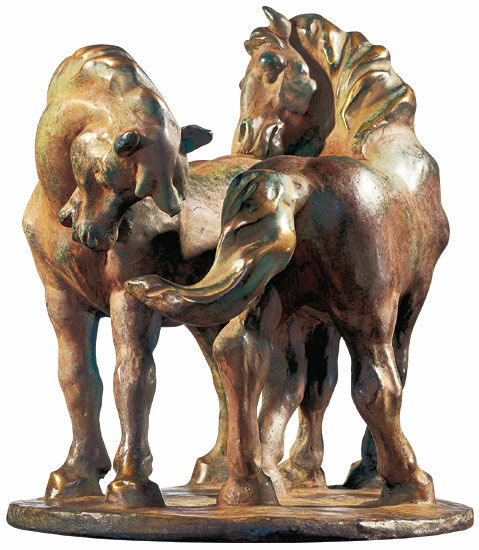Sculpture "Two Horses" (1908/09), bonded bronze version
Sculpture "Two Horses" (1908/09), bonded bronze version
Quick info
bonded bronze | patinated | size 23 x 22 cm (w/h)
Detailed description
Sculpture "Two Horses" (1908/09), bonded bronze version
The horse in all its elegance and vitality, became a symbol of life, reality and freedom for Marc. It symbolises the power of culture; it is the horse that makes agriculture and mobility possible for humans. But nature was already there before the human being: free, untouched and powerful.
Sculptor's model after the original in the Städtische Galerie im Lenbachhaus, Munich (Catalogue raisonné Lankheit 906). A picture of tenderness, dynamism and perfect harmony is offered by Franz Marc's powerfully modelled pair of horses - a symbol of modern sculpture.
Edition in polymer bonded bronze, cast and patinated by hand. Size 23 x 22 cm (w/h).

About Franz Marc
1880-1916
Franz Marc's unique talent was recognised and encouraged at the Munich Academy. On several trips to Paris, he discovered the works of van Gogh for the first time, which made a significant impression on him and helped him to develop an independent artistic language. Through his friend August Macke, he met Wassily Kandinsky, Gabriele Münter and Alfred Kubin, with whom he founded the Expressionist artists' association "Der Blaue Reiter" in 1911. At the outbreak of World War I, Marc was drafted into military service and died two years later in the Battle of Verdun.
Marc examined Naturalism, Art Nouveau and French Impressionism, but sought a new language of expression in order to be able to depict "the spiritual essence of things". With unprecedented consistency, he approached a new form of art in which colours acquired a symbolic meaning far beyond naturalistic representation: "Every colour must clearly say who and what it is, and must be set on clear shapes", Marc explained. For him, blue is the colour of the spiritual, red is love, passion and vulnerability, yellow is the sun and femininity.
Animal, in particular, were the focus of his painting, as they, in contrast to people, symbolised originality and purity to him. Just like Kandinsky, he sought the renewal of the spiritual in art.
The German artists‘ association "Der Blaue Reiter" ("The Blue Rider") was founded in Munich in 1911 by Wassily Kandinsky and Franz Marc during the German Expressionist period.
The name was originally the title of the painting by Kandinsky and also the title of the almanac published by Kandinsky and Marc. Members included Paul Klee and August Macke. The group criticised the prevailing art canon as too academic and elitist and demanded more openness and diversity. The artists turned away from realism and began to paint expressively in an increasingly abstract style using strong colours.
The group disbanded at the beginning of World War I.
Artistic movement that replaced Impressionism in the early 20th century.
Expressionism is the German form of the art revolution in painting, graphic art and sculpture, which found its precursor in the works of Paul Cézanne, Vincent van Gogh and Paul Gauguin in the late 19th century. The Expressionists attempted to advance to the primal elements of painting. With vibrant, unbroken colours in large areas and with the emphasis on the line and the resulting targeted suggestive expressiveness, they fought against the artistic taste established by the bourgeoisie.
The most important representatives of Expressionism were the founders of "Die Brücke" (The Bridge): Ernst Ludwig Kirchner, Erich Heckel, Karl Schmidt-Rottluff, Max Pechstein, Otto Mueller and Franz Marc, August Macke and others.
Masters of Viennese Expressionism are Egon Schiele and Oskar Kokoschka. Among the sculptors, Ernst Barlach is the most famous.
Fauvism is the French form of Expressionism.
Bronze powder is polymer-bonded. Special polishing and patination techniques give the surface of the casting an appearance similar to the bronze.
A plastic work of sculptural art made of wood, stone, ivory, bronze or other metals.
While sculptures from wood, ivory or stone are made directly from the block of material, in bronze casting a working model is prepared at first. Usually, it is made of clay or other easily mouldable materials.
The prime time of sculpture after the Greek and Roman antiquity was the Renaissance. Impressionism gave a new impulse to the sculptural arts. Contemporary artists such as Jorg Immendorf, Andora, and Markus Lupertz also enriched sculptures with outstanding works.


